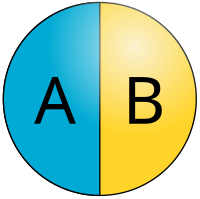
Photo from wikipedia
In recent years, nonconjugated, fluorophore-free organic polymers have emerged as potentially useful light-emitting materials. The fluorescence properties of a novel class of nonconjugated, tert-butyl carboxylate functionalized stilbene-containing alternating copolymers are… Click to show full abstract
In recent years, nonconjugated, fluorophore-free organic polymers have emerged as potentially useful light-emitting materials. The fluorescence properties of a novel class of nonconjugated, tert-butyl carboxylate functionalized stilbene-containing alternating copolymers are investigated in this work. These sterically crowded, semi-rigid copolymers exhibit very strong blue fluorescence in organic solvents upon irradiation. The origin of the fluorescent band with high quantum yield is attributed to the "through space" π-π interactions between the phenyl rings from the stilbene and CO groups from the anhydride groups. To the best of our knowledge, the di-tert-butyl group-containing stilbene and maleic anhydride alternating copolymer showed one of the highest fluorescent intensities among all fluorophore-free polymers. The excellent linearity of the luminescence property of this copolymer is an important attribute for future potential quantitative applications. The fluorescence is maintained when the tert-butyl groups are removed and the resulting carboxylic acid-functionalized copolymer is dissolved in water at neutral pH, which can render these copolymers as attractive candidates for diagnostic and therapeutic applications.
Journal Title: Macromolecular rapid communications
Year Published: 2018
Link to full text (if available)
Share on Social Media: Sign Up to like & get
recommendations!